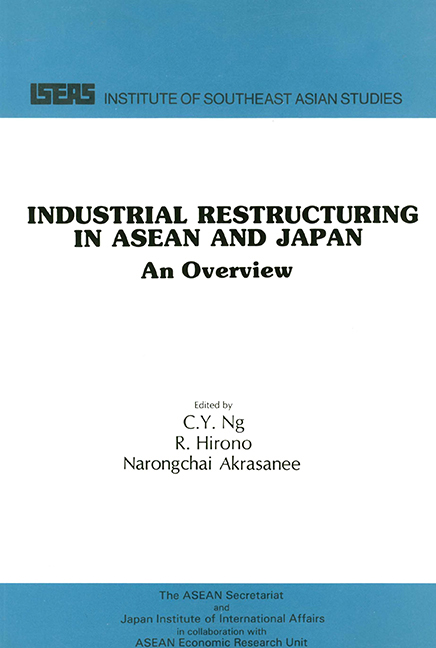Book contents
- Frontmatter
- Contents
- List of Tables
- Foreword
- Preface
- PART ONE ASEAN OVERVIEW
- PART TWO JAPAN OVERVIEW
- 1 JAPAN'S CHANGING INDUSTRIAL STRUCTURE: GROWTH AND DECLINING INDUSTRIES
- 2 CHANGING COMPARATIVE ADVANTAGES
- 3 CORPORATE RESPONSES TO INDUSTRIAL RESTRUCTURING AT HOME AND ABROAD
- 4 INDUSTRIAL RESTRUCTURING POLICY: DOMESTIC DIMENSIONS
- 5 RESTRUCTURING POLICY: INTERNATIONAL DIMENSIONS
- 6 CONCLUSIONS AND RECOMMENDATIONS
- THE EDITORS
6 - CONCLUSIONS AND RECOMMENDATIONS
from PART TWO - JAPAN OVERVIEW
Published online by Cambridge University Press: 21 October 2015
- Frontmatter
- Contents
- List of Tables
- Foreword
- Preface
- PART ONE ASEAN OVERVIEW
- PART TWO JAPAN OVERVIEW
- 1 JAPAN'S CHANGING INDUSTRIAL STRUCTURE: GROWTH AND DECLINING INDUSTRIES
- 2 CHANGING COMPARATIVE ADVANTAGES
- 3 CORPORATE RESPONSES TO INDUSTRIAL RESTRUCTURING AT HOME AND ABROAD
- 4 INDUSTRIAL RESTRUCTURING POLICY: DOMESTIC DIMENSIONS
- 5 RESTRUCTURING POLICY: INTERNATIONAL DIMENSIONS
- 6 CONCLUSIONS AND RECOMMENDATIONS
- THE EDITORS
Summary
Ever since the end of the economic reconstruction of post-war Japan in 1952 or so, there has been a steady process of unidirectional industrial restructuring, moving from a composite of the labour-intensive light industries to what the Japanese nowadays call the heavy, thick, long, and large (HETHILL) industries and on to the so-called light, thin, short, and small (LITHISS) industries. The prima donnas in the leading industries have shifted from textiles, low-cost apparel, toys, and plywood manufacturing industries through petro-chemicals, iron and steel, nonferrous metals, and heavy general and electrical machinery, and shipbuilding to consumer and industrial electronics including VTRs and semiconductors, precision equipment, biotechnology, and new materials such as optical fibres and new ceramics.
The process of Japan's industrial restructuring had proceeded very smoothly during the first phase in the 1950s and 1960s from the labour-intensive light industries lo the heavy and chemical industries. It coincided with the period when the Japanese economy, assisted by the ongoing international economic environment toward trade liberalization and the expanding world economy, fully took advantage of the well-educated and hard-working labour force, the high rate of domestic savings, the active entrepreneurial spirit precipitated by the structural reforms installed by the Allied Occupation Forces and the government's high-growth policies, and was growing at the annual average rate of over 10 per cent.
While there were some declining industries such as coal-mining appearing on the industrial scene even during the first phase, it was relatively easy for the Japanese economy to absorb the adverse impact on capital and human resources, since there were so many rapidly expanding industries creating new jobs and growth opportunities for all the enterprising private sector industrialists. All that the Japanese Government had to do was “not to stand in their way” and assist the private sector entrepreneurs to obtain the required technologies and markets overseas.
- Type
- Chapter
- Information
- Industrial Restructuring in ASEAN and JapanAn Overview, pp. 109 - 116Publisher: ISEAS–Yusof Ishak InstitutePrint publication year: 1987

